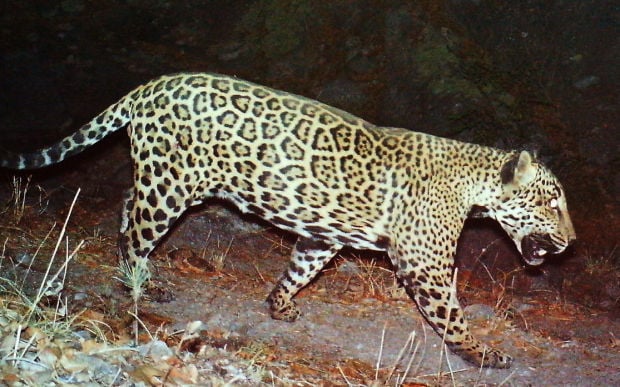Nearly 17 years after gaining endangered status in the United States, the jaguar on Tuesday got nearly 765,000 acres of legally designated prime Southwestern habitat to help it survive and recover.
But it’s not clear how the U.S. Fish and Wildlife Service decision creating jaguar critical habitat in 15 Southern Arizona mountain ranges and a small slice of southwest New Mexico will affect future projects there — beyond the proposed Rosemont Mine, which the service has said will be OK.
The area designated on Tuesday was nearly 100,000 acres less than was once proposed as critical habitat. The Tohono O’odham Reservation and Fort Huachuca, which contained large blocks of proposed critical habitat, were knocked out of the final habitat area because the service said both entities are doing good conservation work already.
The Rosemont Mine site, in the Santa Rita Mountains southeast of Tucson, stayed in the final habitat designation.
Critical habitat legally protects these lands from destruction or severe modification by land clearing. But last year, the Wildlife Service issued a biological opinion saying the Rosemont Mine won’t destroy or “adversely modify” such habitat.
The mine will require fencing off 3,513 acres near where the United States’ only known wild jaguar has been photographed recently. Rosemont will directly affect another 499 acres of the habitat with new roads and trails, the Wildlife Service said.
The service reasoned that this area is far less than 1 percent of the total critical habitat. The area won’t be large enough to block the animal’s movements between the U.S. and Mexico, the service said.
But that opinion doesn’t automatically mean another large project in jaguar habitat — such as housing, new mining or commercial development — will get the same treatment as Rosemont, a Wildlife Service official said Tuesday.
“There’s no specific hard and fast answer as to when a federal action is or isn’t destruction or adverse modification of critical habitat, and therefore prohibited,” said Steve Spangle, chief field supervisor for the service’s Arizona offices. “A different project, at a different place or different time, would have to undergo its own fact-specific analysis.”
The Center for Biological Diversity, the Tucson-based environmental group whose litigation led to Tuesday’s habitat decision, says that to speculate on the Rosemont opinion’s impact on other projects is looking too far ahead. That’s because the center’s activists plan to challenge Rosemont’s biological opinion in court if the mine is ultimately approved by the Forest Service.
Center officials have said that it’s premature for the Wildlife Service to say that jaguar habitat damaged by the mine isn’t important because the feds haven’t yet established formal jaguar recovery goals.
“We interpret this designation to mean that the Santa Ritas are protected from the mine,” said Michael Robinson, a conservation advocate for the center. “The biological opinion is an opinion. This is the final rule.”
Rosemont Copper, which once strongly opposed the critical-habitat designation, doesn’t plan to fight it in court, said Jan Howard, a company spokeswoman.
“Our impacts have already been addressed in all the plans for Rosemont. It’s been addressed in the biological opinion and the final environmental impact statement,” Howard said.
This habitat decision was born in controversy.
From the time the jaguar was listed as endangered in mid-1997, the Wildlife Service, public-lands ranchers and the Arizona Game and Fish Department opposed critical habitat. Ranchers were concerned it would lead to jaguar reintroduction or give environmentalists a legal opening to try to shut ranches down.
They all argued it made no sense to protect jaguar habitat here when the overwhelming share of the animal’s current homeland is south of the border with Mexico.
But a lawsuit by the Center for Biological Diversity and the Defenders of Wildlife led to a federal court ruling in 2009 tossing out an earlier Wildlife Service decision not to designate critical habitat.
Today, the habitat designation is long overdue, said a veteran jaguar advocate, Sergio Avila, a biologist and program manager for the conservationist Sky Island Alliance.
Avila noted that it’s been 18 years since jaguar Macho B — who died by euthanasia five years ago this week — was first sighted in the Baboquivari Mountains and since Southern Arizona rancher Warner Glenn saw a second jaguar in the Peloncillo Mountains.
“Finally we have leadership to designate critical habitat for the jaguars,” Avila said. “A lot of time has been wasted.”
He said that one of many things about this designation worth celebrating is that all projects within critical habitat that lie on federal land have federal funding or need a federal permit will need a formal review of their habitat impacts. That brings science into the picture, he said.
But for Arizona Game and Fish, the designation means another layer of bureaucracy to get through to do things on this land that could modify the environment, spokesman Jim Paxon said.
“The service has made guarantees it won’t affect private landowners and standard land management practices,” he said. But now, the state agency will need formal reviews for activities such as prescribed burning or building or modifying water tanks, he said.
“We have such a little bit of total habitat for the jaguars. Are we going to be able to make a difference in persistence for the species with such limited habitat here?” he asked.
Patrick Bray, executive vice president of the Arizona Cattlemen’s Association, didn’t return calls Tuesday seeking comment on the habitat decision.





